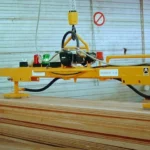In today’s fast-paced industrial environment, automation is not just a competitive advantage it’s a necessity. Among the many technologies powering this evolution, vacuum material handling has emerged as a highly efficient and flexible solution for the movement, placement, and packaging of a wide range of materials. From lifting heavy metal sheets to transferring delicate electronics, vacuum systems offer precision and safety in material handling processes across many industries.
This article explores how vacuum material handling works, its components, applications, and the benefits it delivers in industrial automation.
What Is Vacuum Material Handling?
Vacuum material handling refers to the use of vacuum-based technology to move, lift, or transport materials without direct mechanical gripping. Instead of relying on clamps or hooks, vacuum systems create a pressure differential between a vacuum source and the surrounding atmosphere to generate suction. This suction allows the system to securely attach to a surface and lift or move the object as needed.
It is commonly used in automated systems to handle items of various shapes, sizes, and weights—especially in scenarios where conventional handling may be inefficient or damaging.
Key Components of a Vacuum Material Handling System
A vacuum material handling system consists of several integrated components, each playing a specific role in the automation process:
1. Vacuum Generator
The heart of any vacuum system is the vacuum generator. This can be:
-
Venturi ejectors (air-driven for simplicity and low maintenance),
-
Electric vacuum pumps (ideal for higher suction and continuous duty applications).
The generator creates the pressure differential needed to form a vacuum seal with the load.
2. Suction Cups or Pads
These are the interface between the handling system and the object. Available in various shapes, sizes, and materials, suction cups are designed to accommodate:
-
Smooth or rough surfaces
-
Flat or curved items
-
Sensitive or heavy-duty materials
Specialized suction pads are used for items like glass panels, cardboard boxes, or porous materials.
3. Vacuum Tubing and Valves
These components deliver vacuum pressure from the generator to the suction cups. Valves help regulate the flow and can isolate sections of the system for efficiency.
4. Frame or Robot Arm
Depending on the application, the vacuum system can be mounted to:
-
A fixed gantry or linear track system
-
An articulated robotic arm
-
A mobile lifting device or crane
This integration allows the system to move the object in the desired direction or to a specific location in the production process.
How Vacuum Material Handling Works in Automation
Let’s walk through the typical process:
Step 1: Detection and Positioning
Sensors or vision systems identify the exact position and orientation of the item to be picked. This data is relayed to a robotic controller or PLC (Programmable Logic Controller) for alignment.
Step 2: Engagement
The suction cups lower onto the item, and the vacuum generator activates, drawing air out from the cups and forming a seal. This vacuum pressure holds the item securely without damaging its surface.
Step 3: Transport
The robotic arm or conveyor moves the item to its next destination—be it a different part of the line, packaging area, or storage location.
Step 4: Release
The vacuum is released by opening the valves or deactivating the generator, allowing the item to be dropped or placed gently.
This cycle can occur in fractions of a second in high-speed production environments, showcasing the precision and efficiency of vacuum material handling systems.
Applications of Vacuum Material Handling
Vacuum handling systems are widely used in:
-
Automotive manufacturing: Lifting and placing sheet metal, glass windshields, and molded parts.
-
Electronics assembly: Handling delicate PCBs and components without static discharge or physical damage.
-
Food processing: Moving packaged items and sealed bags with hygienic suction systems.
-
Warehouse and logistics: Picking and placing boxes or pallets in automated storage and retrieval systems (AS/RS).
-
Printing and paper handling: Managing sheets, rolls, and stacks without tearing or jamming.
Its versatility makes vacuum material handling suitable for nearly any industry dealing with repetitive lifting, stacking, or moving operations.
Advantages of Vacuum Material Handling in Automation
There are several key reasons manufacturers choose vacuum-based systems:
1. Non-Damaging Grip
Since there’s no need for clamps or mechanical pressure, fragile or delicate items can be handled safely.
2. Versatility
A single system can handle objects of different shapes and materials, reducing the need for multiple grippers or tools.
3. Speed and Precision
Automated vacuum systems are highly repeatable and can achieve fast cycle times in continuous operations.
4. Reduced Labor Costs
By automating material handling tasks, companies can minimize manual lifting, improve worker safety, and reduce injury-related downtime.
5. Compact and Scalable
Vacuum material handling systems are often modular, allowing them to be scaled or adapted easily to changing production needs.
Considerations and Limitations
While vacuum handling is highly effective, it’s not suitable for every scenario. Consider the following:
-
Surface Conditions: Porous or highly textured surfaces may prevent a proper vacuum seal.
-
Weight Limits: Larger and heavier objects require more vacuum force and stronger structural support.
-
Environmental Factors: Extreme temperatures, dust, and humidity can affect vacuum performance and suction reliability.
System designers must evaluate these factors during the planning phase to ensure optimal performance and safety.
The Future of Vacuum Material Handling in Industry 4.0
As smart factories embrace IoT and advanced robotics, vacuum material handling is evolving. Emerging technologies such as:
-
Real-time pressure monitoring
-
Predictive maintenance sensors
-
AI-based pick-and-place algorithms
are making vacuum systems more intelligent, adaptive, and responsive. These innovations will further improve uptime, reduce energy consumption, and enable fully autonomous handling across diverse applications.
Conclusion
Vacuum material handling plays a critical role in modern industrial automation, enabling fast, safe, and efficient movement of products throughout production lines. Its non-contact nature, adaptability, and ease of integration with automated systems make it a preferred solution for manufacturers seeking to boost productivity and quality.

